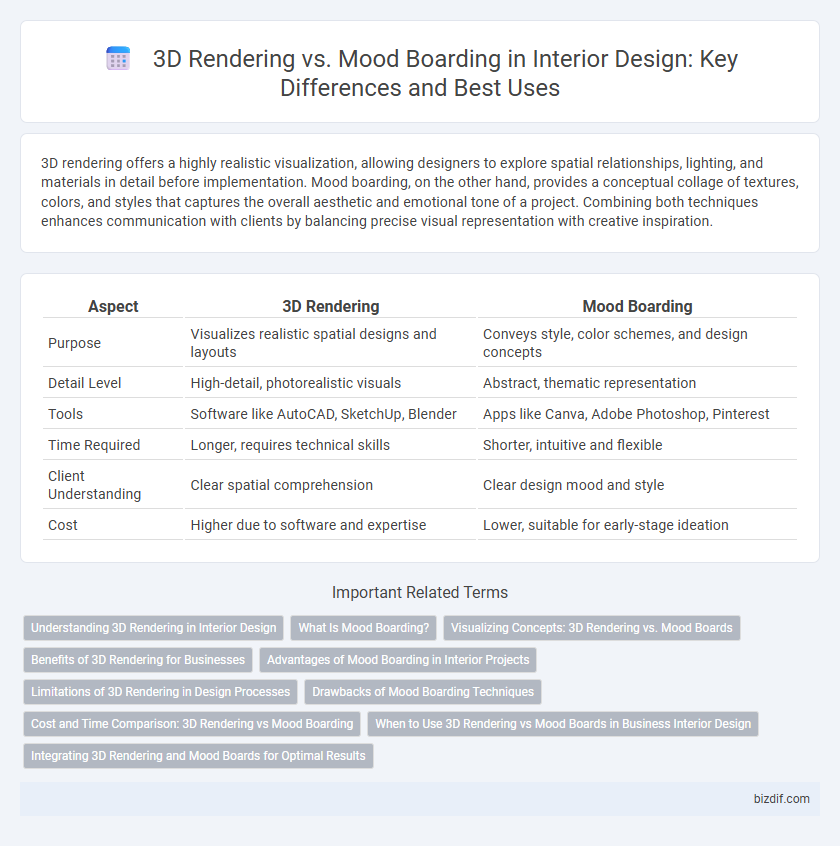3D rendering offers a highly realistic visualization, allowing designers to explore spatial relationships, lighting, and materials in detail before implementation. Mood boarding, on the other hand, provides a conceptual collage of textures, colors, and styles that captures the overall aesthetic and emotional tone of a project. Combining both techniques enhances communication with clients by balancing precise visual representation with creative inspiration.
Table of Comparison
| Aspect | 3D Rendering | Mood Boarding |
|---|---|---|
| Purpose | Visualizes realistic spatial designs and layouts | Conveys style, color schemes, and design concepts |
| Detail Level | High-detail, photorealistic visuals | Abstract, thematic representation |
| Tools | Software like AutoCAD, SketchUp, Blender | Apps like Canva, Adobe Photoshop, Pinterest |
| Time Required | Longer, requires technical skills | Shorter, intuitive and flexible |
| Client Understanding | Clear spatial comprehension | Clear design mood and style |
| Cost | Higher due to software and expertise | Lower, suitable for early-stage ideation |
Understanding 3D Rendering in Interior Design
3D rendering in interior design creates photorealistic visualizations that help clients and designers accurately perceive spatial arrangements, materials, lighting, and textures before implementation. This technique enhances decision-making by allowing virtual walkthroughs and real-time modifications, reducing costly errors during construction. Unlike mood boarding, which conveys conceptual ideas through images and color palettes, 3D rendering offers precise, immersive representations tailored to project specifications.
What Is Mood Boarding?
Mood boarding is a visual tool used in interior design to compile color schemes, textures, furniture styles, and inspirational images into a cohesive collage that conveys the desired aesthetic and atmosphere of a space. It helps designers and clients align on the overall concept, style direction, and emotional tone before detailed plans or 3D renderings are created. This process facilitates creative exploration and decision-making by providing a tangible reference for the project's visual identity.
Visualizing Concepts: 3D Rendering vs. Mood Boards
3D rendering provides photorealistic visualizations that enable clients to experience spatial depth, lighting, and material textures with high accuracy, enhancing decision-making in interior design. Mood boards compile color palettes, textures, and inspirational images to convey the overall aesthetic and emotional tone, fostering early conceptual alignment. Combining both tools streamlines project communication by balancing detailed spatial understanding with creative thematic direction.
Benefits of 3D Rendering for Businesses
3D rendering offers businesses a dynamic and precise visualization of interior design projects, allowing for real-time adjustments and immersive client presentations that enhance decision-making and reduce costly revisions. Unlike mood boarding, which primarily conveys a static collection of style ideas, 3D rendering provides detailed spatial awareness, lighting effects, and material textures that drive clearer communication and alignment between designers and clients. This technology accelerates project timelines and improves client satisfaction, ultimately delivering a stronger competitive edge in the interior design industry.
Advantages of Mood Boarding in Interior Projects
Mood boarding enhances interior design projects by providing a clear visual representation of color schemes, textures, and furniture styles, fostering cohesive design decisions early in the process. It enables effective communication between designers and clients, ensuring alignment on aesthetic preferences and project goals. Mood boards streamline creativity and reduce costly revisions by establishing a unified design vision before detailed 3D renderings are developed.
Limitations of 3D Rendering in Design Processes
3D rendering provides realistic visualizations but often lacks the emotional and tactile nuances captured in mood boards, limiting its effectiveness in conveying ambiance. Complex materials and subtle lighting effects can be difficult to replicate accurately in 3D models, which may result in less immersive presentations. Dependence on software and technical skills can also hinder spontaneous creativity and client engagement during the design process.
Drawbacks of Mood Boarding Techniques
Mood boarding techniques often lack the ability to fully visualize spatial dimensions and realistic lighting, which can lead to misinterpretations of the final interior design. The static nature of mood boards limits client engagement and fails to convey dynamic material interactions or textures effectively. This can result in costly revisions and extended project timelines due to insufficient clarity in design intent.
Cost and Time Comparison: 3D Rendering vs Mood Boarding
3D rendering typically requires higher upfront costs due to software expenses and skilled labor but offers faster visualization with precise details, reducing design revision time. Mood boarding is more cost-effective and quicker to create, relying on curated images and materials, yet it may extend project timelines due to less detailed representation and potential client miscommunication. Balancing budget and project deadlines depends on the scope, with 3D rendering favored for complex designs and mood boards suitable for initial concept exploration.
When to Use 3D Rendering vs Mood Boards in Business Interior Design
3D rendering is essential for presenting realistic, detailed visualizations of business interiors, allowing clients to experience spatial arrangements, materials, and lighting before implementation. Mood boards are ideal during the initial design phase to communicate conceptual ideas, color schemes, and overall aesthetics, helping align client preferences and inspire creativity. Use mood boards for brainstorming and early approvals, then transition to 3D rendering for precise project visualization and final decision-making.
Integrating 3D Rendering and Mood Boards for Optimal Results
Integrating 3D rendering and mood boards enhances interior design by combining realistic visualizations with curated aesthetic concepts, enabling precise spatial planning and cohesive style development. 3D rendering allows designers to present accurate lighting, textures, and furniture placement, while mood boards capture color schemes, materials, and thematic inspirations. Together, they streamline client communication and decision-making, ensuring a well-rounded and visually compelling design outcome.
3D Rendering vs Mood Boarding Infographic

 bizdif.com
bizdif.com